Phylogenetic and Pathotype Analysis of Escherichia coli Stool Isolates from Egyptian Patients with Inflammatory Bowel Disease
Abstract
Introduction
Methods
History taking and clinical data collection
Sample collection and transport
Determination of fecal calprotectin level
Culture of stool samples for isolation of E. coli
Detection of intestinal virulence genes of E. coli using multiplex PCR
Phylogenetic group analysis of E. coli isolates
Antimicrobial susceptibility testing
Statistical analysis
Results
Clinical and laboratory data results
E. coli pathotypes and phylogenetic groups results
Antimicrobial susceptibility results
Discussion
Conclusions
Author Contributions
Funding
Conflicts of Interest
References
- Abraham, C.; Cho, J.H. Inflammatory bowel disease. N Engl J Med 2009, 361, 2066–2078. [Google Scholar] [CrossRef]
- Kaper, J.B.; Nataro, J.P.; Mobley, H.L. Pathogenic Escherichia coli. Nat Rev Microbiol 2004, 2, 123–140. [Google Scholar] [CrossRef] [PubMed]
- Barnich, N.; Carvalho, F.A.; Glasser, A.L.; et al. CEACAM6 acts as a receptor for adherent-invasive E. coli, supporting ileal mucosa colonization in Crohn disease. J Clin Invest 2007, 117, 1566–1574. [Google Scholar] [CrossRef]
- Dogan, B.; Scherl, E.; Bosworth, B.; et al. Multidrug resistance is common in Escherichia coli associated with ileal Crohn’s disease. Inflamm Bowel Dis 2013, 19, 14150. [Google Scholar] [CrossRef]
- Kotlowski, R.; Bernstein, C.N.; Sepehri, S.; Krause, D.O. High prevalence of Escherichia coli belonging to the B2+D phylogenetic group in inflammatory bowel disease. Gut 2007, 56, 669–675. [Google Scholar] [CrossRef]
- Jensen, S.R.; Mirsepasi-Lauridsen, H.C.; Thysen, A.H.; et al. Distinct inflammatory and cytopathic characteristics of Escherichia coli isolates from inflammatory bowel disease patients. Int J Med Microbiol 2015, 305, 925–936. [Google Scholar] [CrossRef]
- Walmsley, R.S.; Ayres, R.C.; Pounder, R.E.; Allan, R.N. A simple clinical colitis activity index. Gut 1998, 43, 29–32. [Google Scholar] [CrossRef] [PubMed]
- Di Palma, J.A.; Farraye, F.A. Crohn’s disease: The first visit. Gastroenterol Hepatol 2011, 7, 163–169. [Google Scholar]
- Tille, P.M. Bailey & Scott’s Diagnostic Microbiology, 13th ed.; Mosby Elsevier: Philadelphia, PA, USA, 2013. [Google Scholar]
- Tobias, J.; Vutukuru, S.R. Simple and rapid multiplex PCR for identification of the main human diarrheagenic Escherichia coli. Microbiol Res 2012, 167, 564–570. [Google Scholar] [CrossRef] [PubMed]
- Clermont, O.; Bonacorsi, S.; Bingen, E. Rapid and simple determination of the Escherichia coli phylogenetic group. Appl Environ Microbiol 2000, 66, 4555–4558. [Google Scholar] [CrossRef]
- Clinical and Laboratory Standards Institute. Performance standards for antimicrobial susceptibility testing; 28th ed. CLSI supplement M100. CLSI: Wayne, PA, USA, 2018. [Google Scholar]
- Petersen, A.M.; Nielsen, E.M.; Litrup, E.; Brynskov, J.; Mirsepasi, H.; Krogfelt, K.A. A phylogenetic group of Escherichia coli associated with active left-sided inflammatory bowel disease. BMC Microbiol 2009, 9, 171. [Google Scholar] [CrossRef]
- Thomazini, C.M.; Samegima, D.A.; Rodrigues, M.A.; Victoria, C.R.; Rodrigues, J. High prevalence of aggregative adherent Escherichia coli strains in the mucosa-associated microbiota of patients with inflammatory bowel diseases. Int J Med Microbiol 2011, 301, 475–479. [Google Scholar] [CrossRef]
- Sokol, H.; Lepage, P.; Seksik, P.; Doré, J.; Marteau, P. Temperature gradient gel electrophoresis of fecal 16S rRNA reveals active Escherichia coli in the microbiota of patients with ulcerative colitis. J Clin Microbiol 2006, 44, 3172–3177. [Google Scholar] [CrossRef]
- de Souza, H.L.; de Carvalho, V.R.; Romeiro, F.G.; Sassaki, L.Y.; Keller, R.; Rodrigues, J. Mucosa-associated but not luminal Escherichia coli is augmented in Crohn’s disease and ulcerative colitis. Gut Pathog 2012, 4, 21. [Google Scholar] [CrossRef]
- Kmetova, M.; Curova, K.; Gombosova, L.; et al. Escherichia coli pathotypes isolated in inflammatory bowel diseases and oncological diseases of gastrointestinal tract. Int J Infect Dis 2008, 12, e454. [Google Scholar] [CrossRef]
- Curová, K.; Kmetová, M.; Sabol, M.; Gombosová, L.; Lazúrová, I.; Siegfried, L. Enterovirulent E. coli in inflammatory and noninflammatory bowel disease. Folia Microbiol (Praha) 2009, 54, 81–86. [Google Scholar] [CrossRef]
- Watanabe, E.; Romeiro, F.; Sassaki, L.; Keller, R.; Rodrigues, J. Enteroaggregative Escherichia coli seems to proliferate in the terminal portion of the colon of IBD patients. Inflamm Bowel Dis 2012, 18, S112. [Google Scholar] [CrossRef]
- da Silva Santos, A.C.; Gomes Romeiro, F.; Yukie Sassaki, L.; Rodrigues, J. Escherichia coli from Crohn’s disease patient displays virulence features of enteroinvasive (EIEC), enterohemorragic (EHEC), and enteroaggregative (EAEC) pathotypes. Gut Pathog 2015, 7, 2. [Google Scholar] [CrossRef]
- Mirsepasi-Lauridsen, H.C.; Halkjaer, S.I.; Mortensen, E.M.; et al. Extraintestinal pathogenic Escherichia coli are associated with intestinal inflammation in patients with ulcerative colitis. Sci Rep 2016, 6, 31152. [Google Scholar] [PubMed]
- Micenková, L.; Frankovičová, L.; Jaborníková, I.; et al. Escherichia coli isolates from patients with inflammatory bowel disease: ExPEC virulence- and colicin-determinants are more frequent compared to healthy controls. Int J Med Microbiol 2018, 308, 498–504. [Google Scholar] [CrossRef] [PubMed]
- De la Fuente, M.; Franchi, L.; Araya, D.; et al. Escherichia coli isolates from inflammatory bowel diseases patients survive in macrophages and activate NLRP3 inflammasome. Int J Med Microbiol 2014, 304, 384–392. [Google Scholar] [CrossRef] [PubMed]
- Nitzan, O.; Elias, M.; Peretz, A.; Saliba, W. Role of antibiotics for treatment of inflammatory bowel disease. World J Gastroenterol 2016, 22, 1078–1087. [Google Scholar] [CrossRef] [PubMed]
- Khan, K.J.; Ullman, T.A.; Ford, A.C.; et al. Antibiotic therapy in inflammatory bowel disease: A systematic review and meta-analysis. Am J Gastroenterol 2011, 106, 661–673. [Google Scholar] [CrossRef] [PubMed]
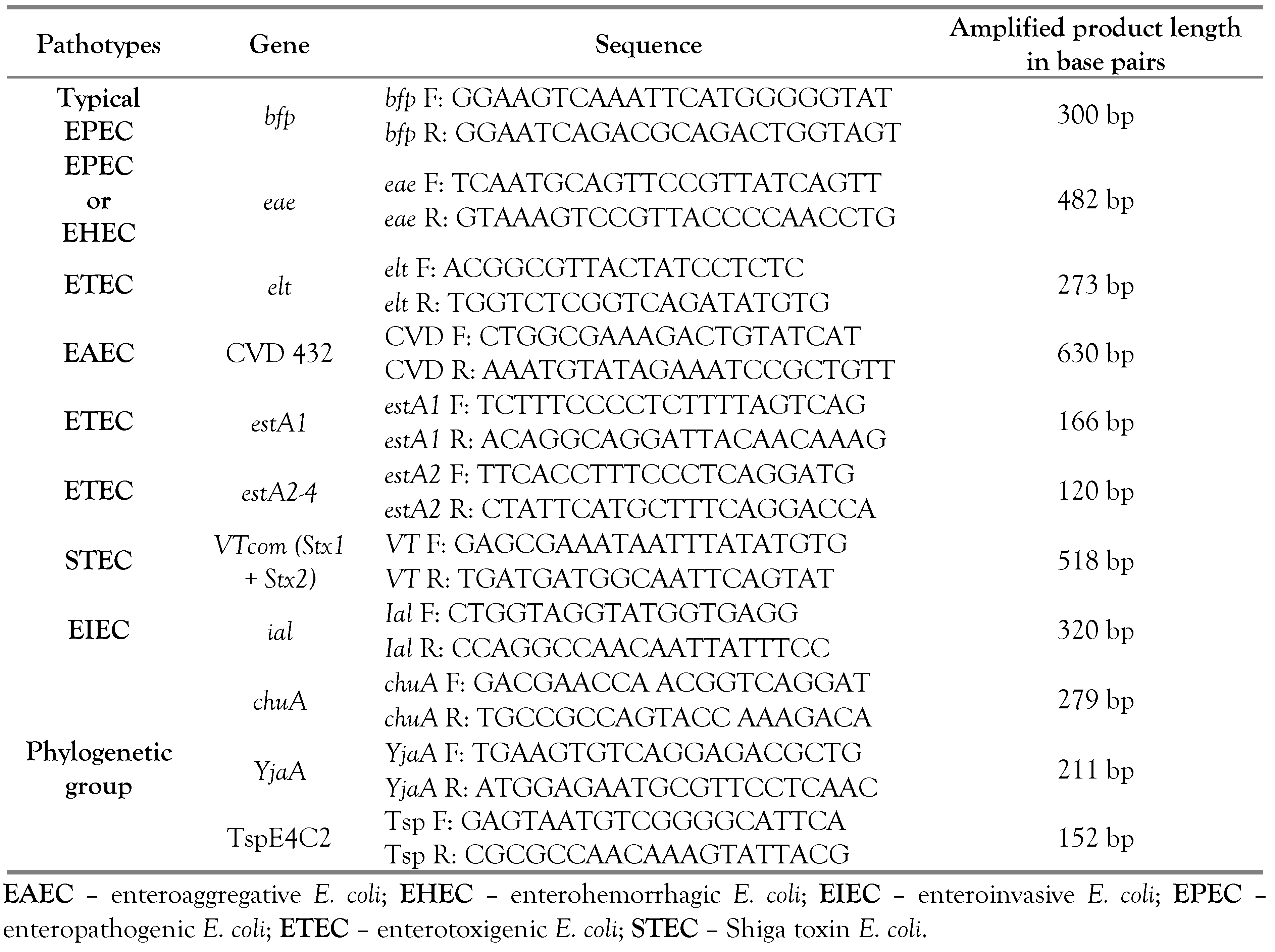

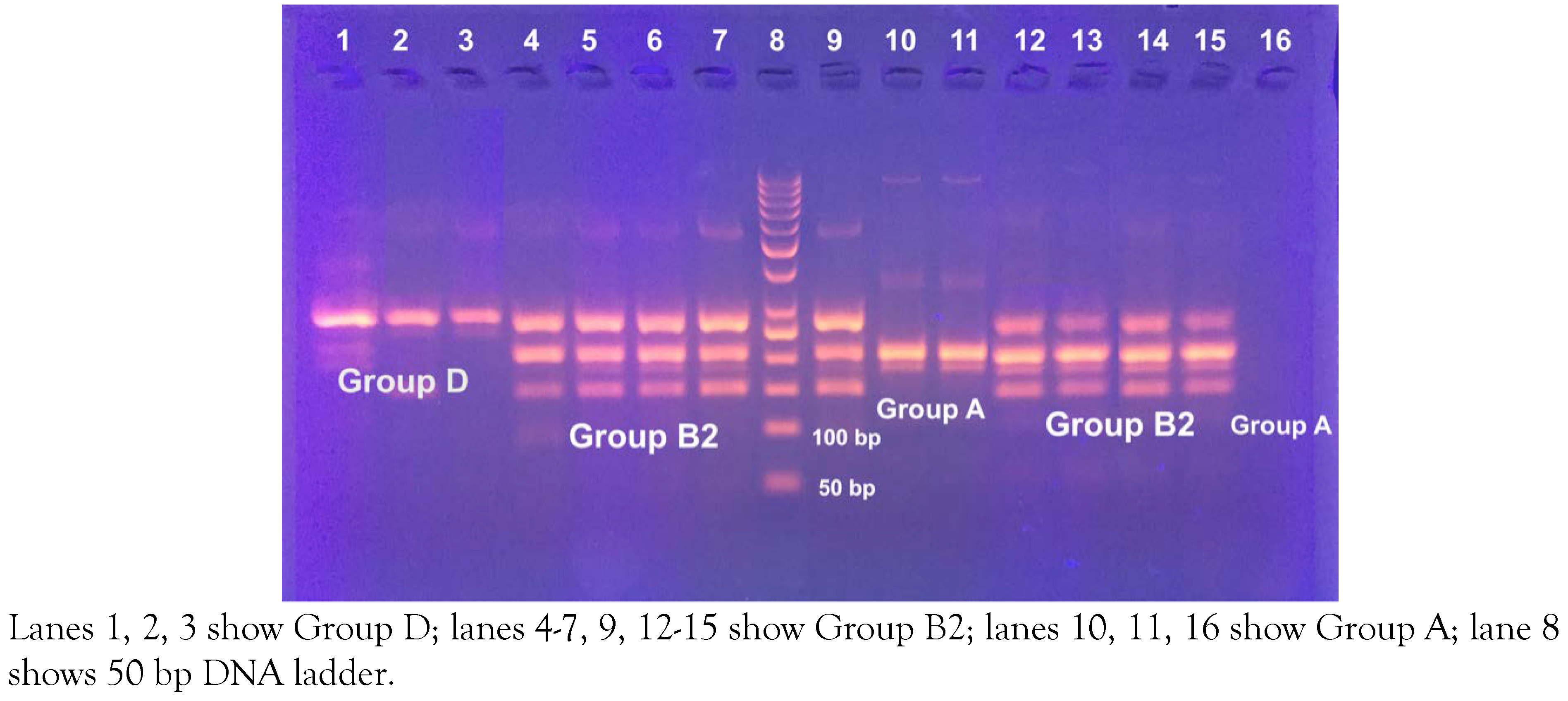
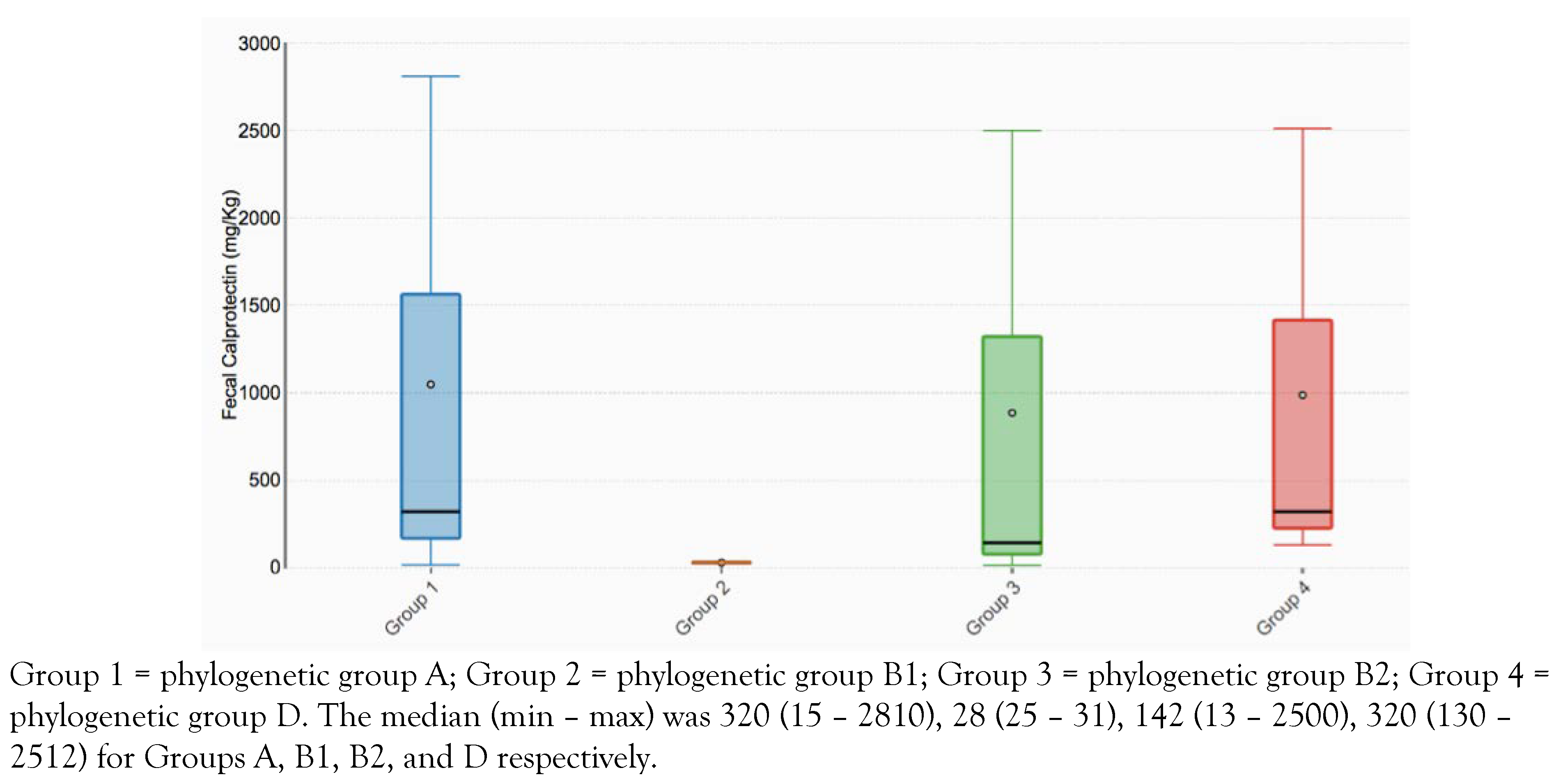
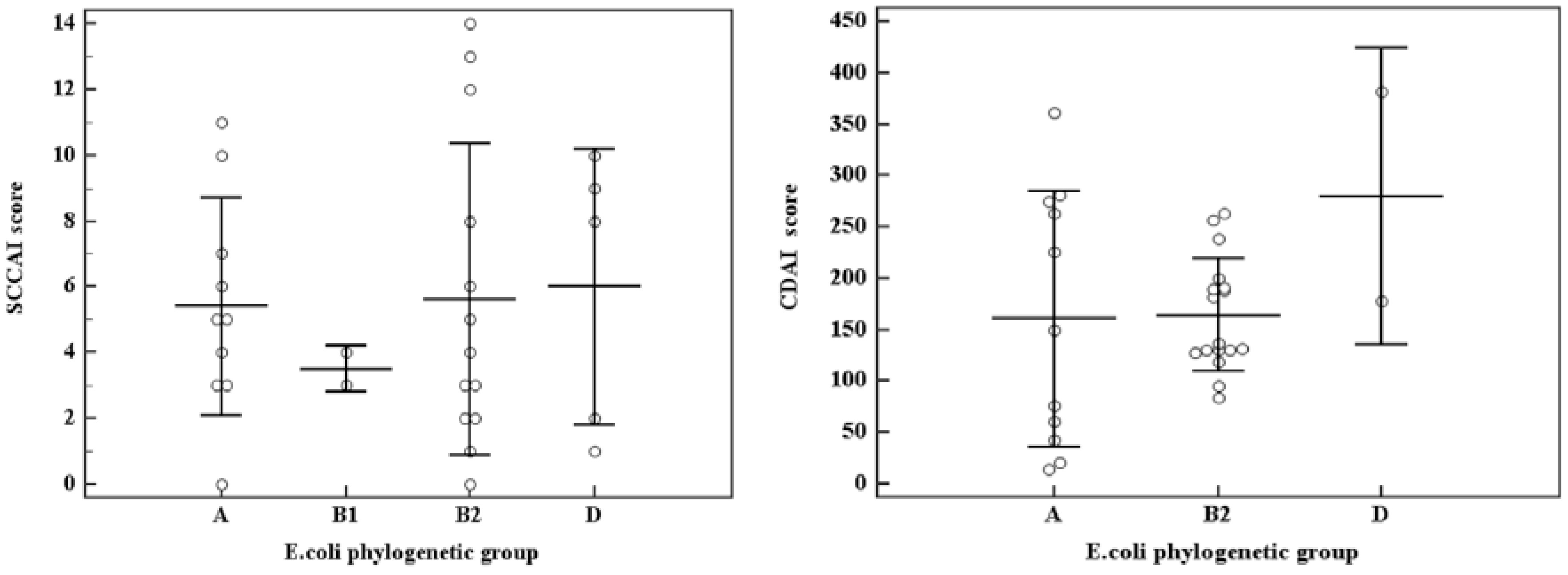
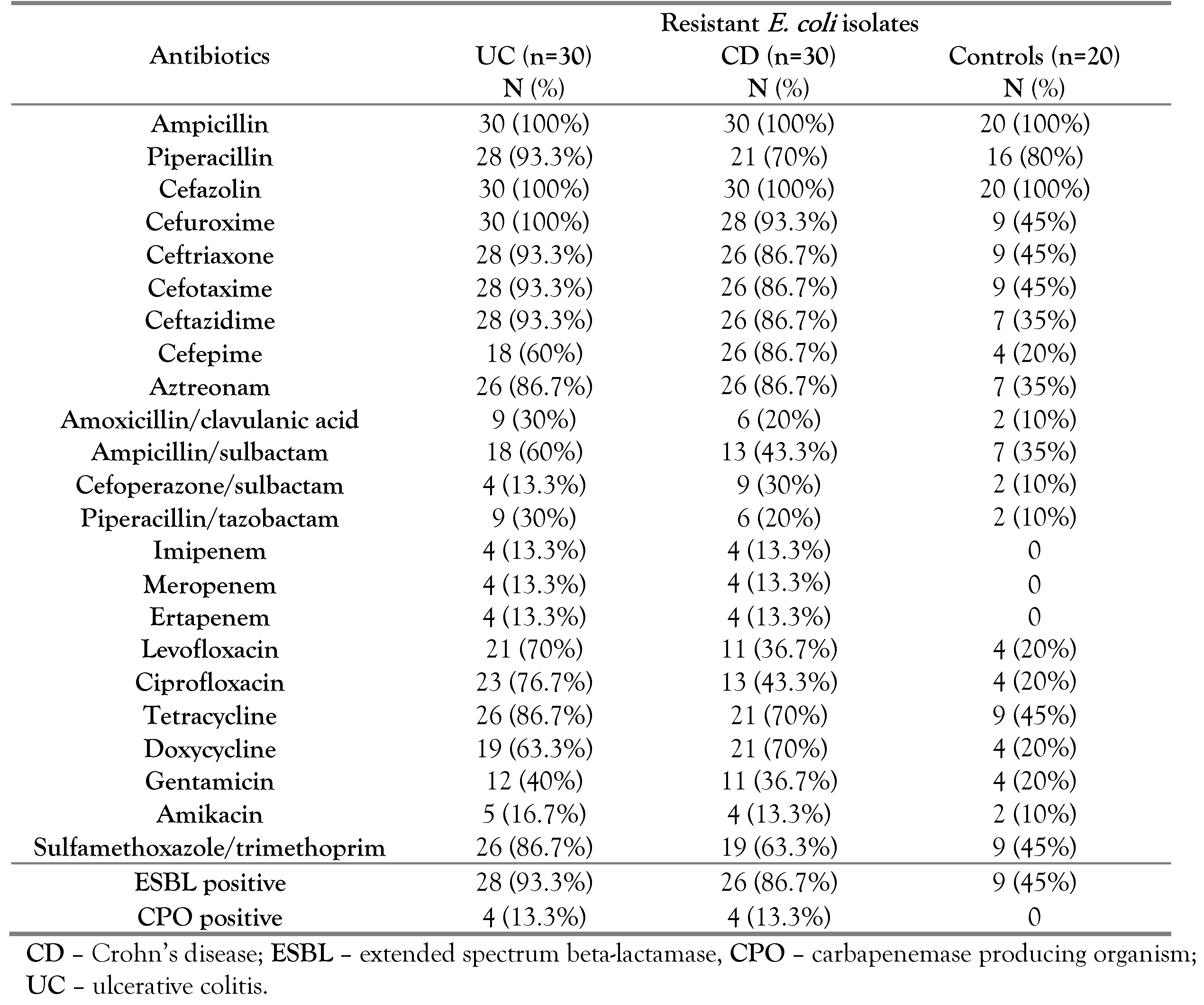
© GERMS 2025.
Share and Cite
Meheissen, M.; Header, D.; Abdelaty, K. Phylogenetic and Pathotype Analysis of Escherichia coli Stool Isolates from Egyptian Patients with Inflammatory Bowel Disease. GERMS 2019, 9, 172-181. https://doi.org/10.18683/germs.2019.1173
Meheissen M, Header D, Abdelaty K. Phylogenetic and Pathotype Analysis of Escherichia coli Stool Isolates from Egyptian Patients with Inflammatory Bowel Disease. GERMS. 2019; 9(4):172-181. https://doi.org/10.18683/germs.2019.1173
Chicago/Turabian StyleMeheissen, Marwa, Doaa Header, and Khaled Abdelaty. 2019. "Phylogenetic and Pathotype Analysis of Escherichia coli Stool Isolates from Egyptian Patients with Inflammatory Bowel Disease" GERMS 9, no. 4: 172-181. https://doi.org/10.18683/germs.2019.1173
APA StyleMeheissen, M., Header, D., & Abdelaty, K. (2019). Phylogenetic and Pathotype Analysis of Escherichia coli Stool Isolates from Egyptian Patients with Inflammatory Bowel Disease. GERMS, 9(4), 172-181. https://doi.org/10.18683/germs.2019.1173



